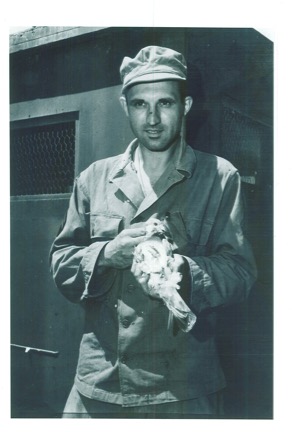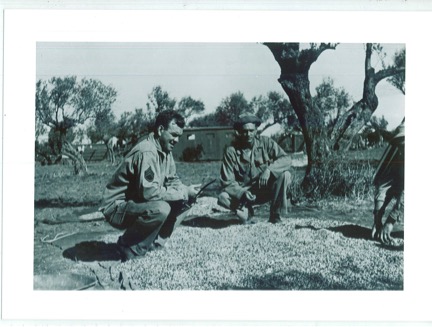The photos below come from the Gordon H. Hayes Collection, catalog number MSS294, held by the Holt-Atherton Special Collections Department at the University of the Pacific Library. Used by permission. You can request reproductions of other materials in the Gordon H. Hayes Collection by contacting librarian Nicole Grady, ngrady@pacific.edu.
Gordon H. Hayes is the author of The Pigeons That Went to War. He served as a pigeoneer in Africa and Italy during World War II.
British pigeons, photo by Hayes
Not labeled
Not labeled
Jim Ginnell banding squabs at the breeding base, Bizerte, Tunisia. The squabs were banded at ten days old.
Not labeled
Price Day, War Correspondent of the Baltimore Sun, using a pigeon at the Cassino front.
Not labeled
Red Bronson, driver of the Bronx Express, one of our combat mobiles, north of Florence, Italy.
Racing Pigeons donated by civilian fanciers awaiting shipment overseas. Fort Geo. Meade, Maryland.
Not labeled
Cpl. Leonard Karnopp, who produced many superb war pigeons, standing in his breeding loft at Bizerte, Tunisia.
French pigeoneers in Casablanca, Morocco. We used their pigeons when we first arrived in Morocco.
Our mobile lofts were in the house to the right. Bolonia, Italy.
This combat loft was hit by artillery fire. Located at the Cassino Front, Italy.
This is Yank. He should be noted for carrying a message which prevented the capture of General Patton. He also delivered the first news of the fall of Gafsa, North Africa.
Repairing a loft.
Not labeled.
The British Combat Mobile Loft in Tunis, Tunisia. It proved unwieldy for tough terrain.
An Italian mobile loft, captured by us in Tunisia.
Not labeled.
Not labeled.
Not labeled.
This bomb fell on Hayes's area. Fortunately, it was a dud.
Left to right: Pvt. Gognon, Pvt. Cash, and Cpl. Roush.
When the projectiles and bombs started coming in, Sgt. Hayes and his crew dove into old German gun emplacements.
Camouflaged and half-buried loft at the Cassino front.
German War Bird doing the Goose Step. Moments later this bird was shot down by American pigeoneers., Via Reggio, Italy.
The combat mobile loft of John Gangulio and Walt Haid in the Futa Pass, Northern Italy.
Yank
WWI 3rd Army
Lt. Ericson and Lt. Buscall, Tebessa
French pigeons, Algiers
Camels
British pigeons, Carthage
Mark VI Tiger Tank
Not labeled
Not labeled
French pigeons, Algiers
L to R: Anthony Scurti, Cletus Moert, and Dapper Dan Martinovich, handlers of the pigeon, Yank, at the Tebessa front, Northern Algeria.
Sgt. Steinhaus, loft rear, just returned for repairs from the Anzio front, San Prisco, Italy. (Notice the shrapnel holes in the loft.)
Herman Williams, co-trainer of the pigeon named Capt. Fulton, examining the wound in the head of his pigeon suffered while carrying a message from the front at Sessa, Italy.
Pigeoneers and combat mobile lofts on the deck of a landing craft during the invasion of Italy at Salerno.
The Italian loft the Allies captured in Genova, Italy, a British major in the foreground. The loft was three stories high with its watch tower station on top.
Pigeoneers and mobile lofts
Lady Astor
Mobile loft
Two pigeons in foreground
Sgt. Hayes, co-trainer of the pigeons Old Seventeen, Rain-in-the-Face, and Hawk Bait, feeding his pigeons at the beach, La Spezia, Italy. Photo also found in The Pigeons That Went to War.
Photo not labeled
The Last Round-up: All combat mobiles back from the field, our last meeting on the bank of the Adige River, Italy. Photo also found in Hayes’s book The Pigeons That Went to War.
Leonard Karnopp holding the freak pigeon with three legs. Bizerte, Tunisia. Hayes writes that The Freak was a great flier and much loved by the pigeoneers.
The main breeding base at San Prisco, Italy.
Photo not labeled.
Photo not labeled.
Half-buried, a camouflaged combat loft at the Anzio beachhead, Italy.
The combat mobile loft of John Gangulio and Walt Haid in the Futa Pass, Northern Italy.


























































